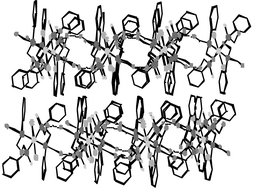Water-soluble hydroxyalkylated phosphines: examples of their differing behaviour toward ruthenium and rhodium
Abstract
The reaction of P(CH2OH)3 (I) and P(C6H5)(CH2OH)2 (II) with RuCl3 in methanol eliminates two equivalents of formaldehyde to yield the mixed tertiary and secondary phosphine complexes all-trans-[RuCl2(P(CH2OH)3)2(P(CH2OH)2H)2] (1) and [RuCl2(P(C6H5)(CH2OH)2)2(P(C6H5)(CH2OH)H)2] (2), respectively. There is a high degree of hydrogen-bonding interactions between the hydroxymethyl groups in 1 and 2, although the phenyl groups of the latter reduce the extent of the network compared to 1. The generation of these mixed secondary and tertiary phosphine complexes is unprecedented. Under the same reaction conditions, the tris(hydroxypropyl)phosphine III formed no ruthenium complex. The reaction of P(CH2OH)3, P(C6H5)(CH2OH)2 and P{(CH2)3OH}3 with [RhCl(1,5-cod)]2 in an aqueous/dichloromethane biphasic medium yielded [RhH2(P(CH2OH)3)4]+ (3), [RhH2(P(C6H5)(CH2OH)2)4]+ (4) and [Rh(P(C6H5)(CH2OH)2)4]+ (5) and [Rh(P{(CH2)3OH}3)4]+ (6), respectively. Treating 5 with dihydrogen rapidly gave 4. The hydroxypropyl compound 6 formed the corresponding dihydride much more slowly in aqueous solution, although [RhH2(P{(CH2)3OH}3)4]+ (7) was readily formed by reaction with dihydrogen. Two separate reaction pathways are therefore involved; for P(CH2OH)3 and to a lesser extent P(C6H5)(CH2OH)2, the hydride source in the product is likely to be the aqueous solvent or the hydroxyl protons, whilst for P{(CH2)3OH}3 an oxidative addition of H2 is favoured. The protic nature of 3 and 4 was illustrated by the H–D exchange observed in d2-water. Dihydrides 3 and 4 reacted with carbon monoxide to yield the dicarbonyl cations [Rh(CO)2(P(CH2OH)3)3]+ (8) and [Rh(CO)2(P(C6H5)(CH2OH)2)3]+ (9). The analogous experiment with [RhH2(P{(CH2)3OH}3)4]+ resulted in phosphine exchange, although our experimental evidence points to the possibility of more than one fluxional process in solution.


 Please wait while we load your content...
Please wait while we load your content...